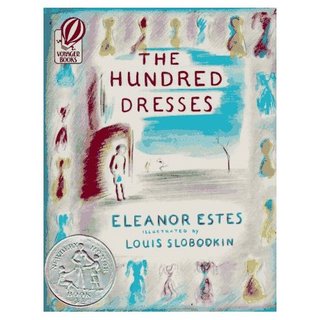Chapter Books - The Hundred Dresses
 The Hundred Dresses by Eleanor Estes and illustrated by Louis Slobodkin 1944
The Hundred Dresses by Eleanor Estes and illustrated by Louis Slobodkin 1944Talk about a book from the past. I had never heard of The Hundred Dresses until I was browsing through the library’s juvenile shelves a few weeks ago. There were three copies in various dust jacket covers, so I thought this is an interesting title I think I will take it with me and look there is a silver Newbery honor sticker. The fact this was written in 1944 and the copy I checked out is from 1971 would surprise some for still being on a shelf in the library system with the continual abundance of new books to stock shelves with. Of course, anything that has an award tag especially of the Newbery kind will be found for years to come in almost any public library or bookstore. But, I must say this smallish chapter book still has appeal and relevance in today’s time.
We meet three elementary age girls whose only real connection is they share the same classroom. Peggy is the popular well-to-do girl, Maddie is Peggy’s best friend, and Wanda is the new girl from the very poor side of town with the funny last name. No one really notices Wanda at first. She keeps to herself, has difficulty in speaking in front of the class, and wears the same blue dress everyday to school. What starts off as a simple statement from Wanda one day as the girls all admire the new dress a classmate is wearing turns into a daily “funning” by the girls. Wanda casually mentions that she has 100 dresses in her closet at home. Since she wears the same dress every day no one believes her and it becomes a game to ask Wanda about her dresses everyday.
The “funning” of Wanda by Peggy and the other girls in class is just a polite way of saying mocking, harassing, or polite bullying. Maddie always accompanies Peggy during these meetings, but says little because she wonders if she stood up to Peggy if she then will be the next target of ridicule. Plus, she thinks what is the harm in poking a little fun it isn’t as if Wanda has told the “truth”. Maddie’s home situation isn’t quite on the same poverty line as Wanda, but she doesn’t have the things Peggy does and could be seen in a different light if she didn’t go along with the popular “opinion”.
After several days of being absent from class, which no one notices, the teacher reads a letter to the class from Wanda’s father. It tells of how he is moving with Wanda and her brother to the big city where people are more accepting of families with funny last names. How Maddie and Peggy react to the news is interesting and realistic. Are they to blame? How can they fix the situation? Did Wanda really have 100 hundred dresses? The author does a great job in bringing the emotions and thinking process of this age group together in a simple and quickly read chapter book. The artist use of vague features and little color for the figures helps keep the story pliable and current as well.
This would be a great book to blow the dust off and read aloud in a classroom setting. From what I have seen there is even a teacher’s guide that goes with it. Of course, I am not sure how current the guide is. The story I think would be a good one to demonstrate to students how “funning” has side effects and consequences that may not always be seen. Would recommend for 2nd grade on up.
Labels: chapter books














2 Comments:
I love this one, PJ! Thanks for the review (and the reminder).
The is an example of a true classic. Newer reprints have a forward by the Estes' daughter where she talks about the backstory of the book. We use it to talk about bullying at our school.
Post a Comment
<< Home